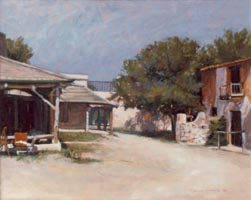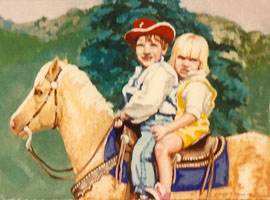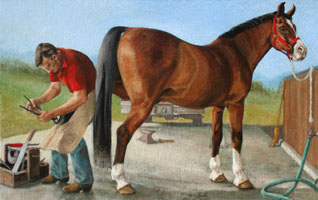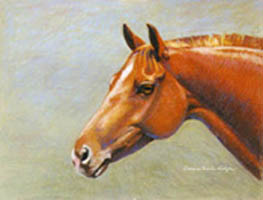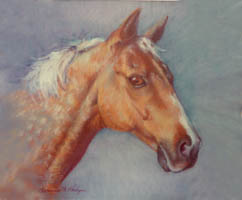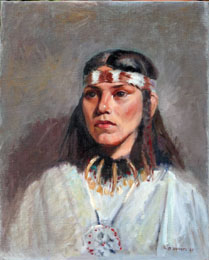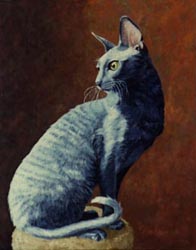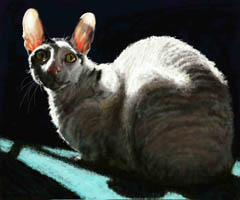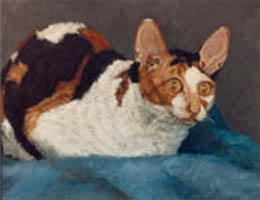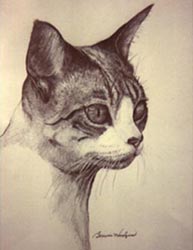I spent many years living in Houston, Texas, which influenced my art. Many of my paintings have a Western theme, such as still lifes of bison and cattle skulls, portraits of Native Americans and cowboys, landscapes and horses.
"West Texas Town"
Oil on Canvas
12 x 16Private Collection
12 x 16Private Collection
This is an oil painting of my grandmother as a young woman in Colorado Springs.

"Pioneer Woman with Burro"
Oil on Canvas
16 x 20
Private Collection
16 x 20
Private Collection
This was a gouache painting of my nephew and one of his cousins at a family reunion in Colorado. I just loved the little pony's expression. He looked sassy!
"Palomino Pony"
Gouache
6 x 10Private Collection
6 x 10Private Collection
This is oil painting is of our first horse, Ibn, being shod by our farrier.
"The Blacksmith"
[Enlarge]
Oil on Canvas
25 x 40

[Enlarge]
Oil on Canvas
25 x 40
 |
| Animal Portraits by Bonnie Hodges |
Baxter was a big leopard-spotted appaloosa that my daughter showed to Second Level dressage. Appaloosas are a breed of horse that were bred by the Nez Perce Indians in the Pacific Northwest. Baxter descended from Red Eagle, who was a famous Appaloosa stallion.

"Leopard-spotted Apaloosa"
[Enlarge]
Watercolor & Gouache
12 x 8
Private Collection
Here is another Appaloosa I painted. This was a commission I did in watercolor:
"Appaloosa Gelding"
Watercolor
18 x 24Private Collection
18 x 24Private Collection
My daughter's horse, Kastanie, was a Quarter Horse mare off the track. Quarter horses are popular for rodeo riding and as ranch horses. Kastanie turned out to be a really nice dressage horse, and showed successfully to Second Level. [Please see "The History of the Quarter Horse and Its Future in Dressage"] Kastanie was so nice that she was approved for the Belgian Warmblood studbook. A young girl in Louisiana bought her as a schoolmaster.
"Belgian Warmblood Mare"
Pastel
22 x 28
Private Collection
This was a palomino gelding at our stable in Houston. I think he was a Quarter Horse, too.
"Palomino Polo Pony"
Pastel
20" diameter
This old buckskin mare was a commission I did for her owners. She may have been another Quarter Horse.
"Buckskin Mare"
Oil on Canvas
24 x 24
Private Collection24 x 24
This digital painting started out as some ink blots that I thought they looked like a horse. So, I painted an old Mustang around them. It turned out pretty successfully - it toured China in an art show through Houston Community College. It was done in Painter X.
"Wild Mustang"
Digital Painting
10 x 7
There were lots of cowboys running around in Texas!
Beverly is a Native American who is wearing her native buffalo-hide dress. Her head-dress is made of pheasant and quail feathers. We think it might be ceremonial. Her necklace is made of bear claws. The medallion reflects her status in the tribe.
"Native American"
[Enlarge]
Oil on Canvas
20 x 16
Here is another one of Beverly in a native buckskin dress. The head-dress indicates tribal membership. That might be bear fur around the bear claws on her necklace. Her status in the tribe is reflected in the medallion.
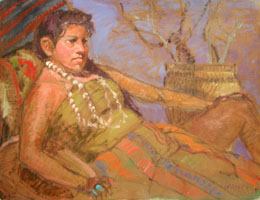
"Native American Woman"
Oil on Paper
22 x 30
22 x 30

"Indian Woman with Tribal Rug"
Oil on Board
20 x 16
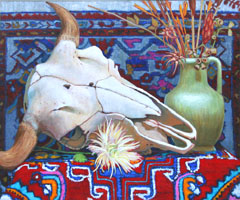
"The Last Buffalo"
Oil on Canvas
40 x 48
This cow was a victim of one of the brutal Texas droughts:

"Antlers"
Watercolor
18 x 24
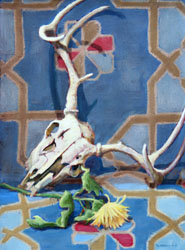
"Deer Antlers"
Oil on Paper
30 x 22
Paintings, prints, and notecards can be ordered by using PayPal or by contacting me at art (at) bonniehodges.com. The paintings are available as prints, even the ones that were sold.
____________________________________________________
Edmonds, Washington
Art (at) bonniehodges.com
Website: bonniehodges.com
Artwork © Bonnie M Hodges 2023
 |
| Order Monsieur Baucher and His Art |
Artwork © Bonnie Hodges 2022

